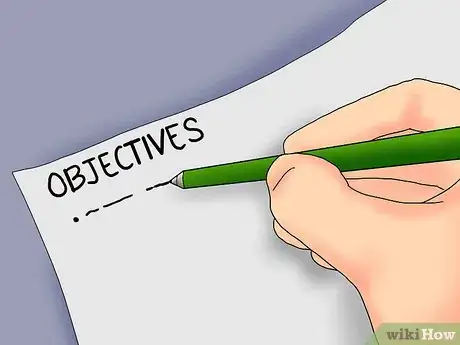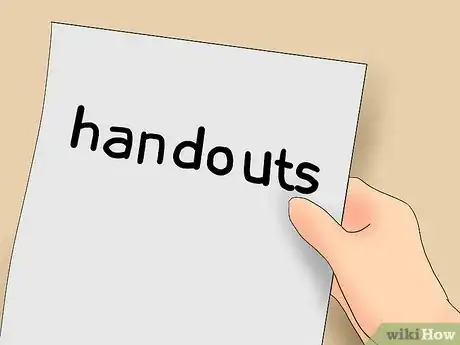X
wikiHow is a “wiki,” similar to Wikipedia, which means that many of our articles are co-written by multiple authors. To create this article, 13 people, some anonymous, worked to edit and improve it over time.
This article has been viewed 13,520 times.
Learn more...
Providing training to a group doesn't have to be stressful. Follow these steps to organize your presentation and speak with confidence in front of a group. Remember that getting a little nervous is perfectly normal, but once you start talking, your focus will be on teaching, not on yourself.
Steps
-
1Plan your class. It is important to jot down exactly what the objectives are for the training. What do you want the class to know or do when you are done with the presentation? What are the most important topics and how much time do you think you'll spend on them? If you are unsure about this, do some research before you begin writing the objectives.
-
2Create a detailed outline. Put your objectives in the order that they should be covered. It's OK to change the order or even the objectives as you develop. Sketch out the class in a detailed outline, thinking about images you'd like to include in the presentation, videos you'd like to show, exercises and other elements of the class. This is your detailed draft. If it needs to be approved, you'll have enough on paper to show a manager, but not so much that you've wasted time developing something that doesn't get used. Keep in mind that this stage can take considerable time because you have to know the topic to produce a detailed outline.Advertisement
-
3Complete the research. If you are not already an expert, now is the time to become one. Don't short change your prep time or you will not be comfortable in the classroom. Know more than you need to know.
-
4Create the presentation. Begin creating your PowerPoint or other presentation. Check to be sure that you are spending the right amount of time on each objective. Many presenters take way too long on background information and run out of time for the most important topics. For example, if you are giving a four hour class on Conflict Management, learning about the theory may be somewhat helpful, but only a short time should be given to that so that the focus can be on the skills needed and the role play practice.
-
5Write a handout. Be sure to use a style sheet in MS Word or whatever program so that your titles and bullets remain consistent in format. Create a simple handout, copying slides into the handout that have important information. Your slides and handout should not be too detailed or the focus will be on reading rather than on you.
-
6Include an exercise. Your content should have a discussion, exercise, video, or some kind of activity about every 15 minutes. People lose attention when pushed to 20 minutes, and tune out lecture shortly after that. Add interest to the handout and presentation with short video clips, humorous cartoons, interesting quotes, and exercises. Have small group discussion to reinforce the material, and quick exercises where people get up and move around to meet others, talking about something related to the content. Don't neglect breaks every 90 minutes or so.
-
7Get the room ready. Make sure you have all equipment ready and tested. Have extra copies of your handout. If you are presenting off site, make sure you have a laptop and a thumb drive with your presentation. Also, carry a copy of your slide set just in case there is a technical problem and you have to resort to paper.
-
8Get yourself ready. Get sleep the night before. Wake up early and eat a normal breakfast. Dress so that you'll feel confident. Don't wear anything that is uncomfortable, including high heels. Arrive early so you'll have a chance to do a quick review of the material and the room. Make sure there are enough seats, handouts, extra pens and whatever other supplies are necessary. Test your mic if you will wear one. Don't allow people in the room until you are set up and ready... they will want to talk with you and it will stress you that you can't focus on preparation.
-
9Get your materials ready. Your handout should have big, bold notes on it to remind you of what you want to say in that section. One or two keywords to help you remember a personal story or an interesting quote is all you need. You won't have time to read long notes while you are talking. Also, have a copy of the slides printed out so that you can see what slides or exercises are coming up. Make sure your presentation has been set up to guide you. For example, put a slide in that says Exercise with an interesting picture related to the topic to help you remember when you will assign an exercise. As they do an exercise, walk around to check on the class, and then glance at the topics coming up next. Make rough notes before you give the class on the time you think you should start each main topic so you can pick up the pace or slow it down if you're not hitting the mark. As you give the presentation, write the actual times for each section in case you have to give the presentation again. (Put your initials on the front cover of your handout so you don't mix it up with the participants' guide as you walk around.)
-
10Finish strong. Have a fun exercise, short powerful video, or group activity at the end to summarize what was covered. Finish on an upbeat note. Let the class know that you'll be available if they have questions after the presentation. Thank the group and tell them they were a great class!
Advertisement
About This Article
Advertisement














-Step-15.webp)
















































